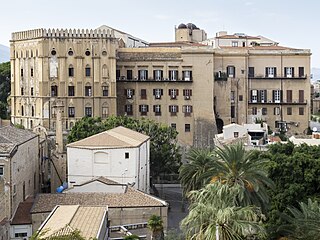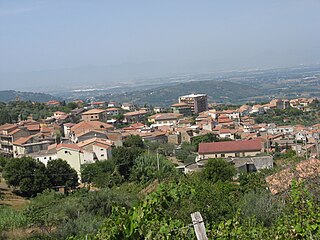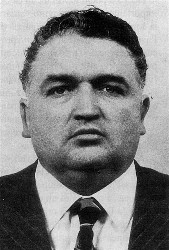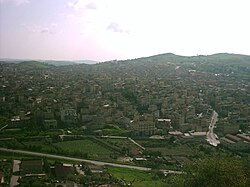
Palermo is a city in southern Italy, the capital of both the autonomous region of Sicily and the Metropolitan City of Palermo, the city's surrounding metropolitan province. The city is noted for its history, culture, architecture and gastronomy, playing an important role throughout much of its existence; it is over 2,700 years old. Palermo is in the northwest of the island of Sicily, by the Gulf of Palermo in the Tyrrhenian Sea.

Alcamo is the fourth-largest town and commune of the Province of Trapani, Sicily, with a population of 44.925 inhabitants. It is on the borderline with the Metropolitan City of Palermo at a distance of about 50 kilometres from Palermo and Trapani.

Caltanissetta is a comune (municipality) in the central interior of Sicily, Italy, and the capital of the province of Caltanissetta. Its inhabitants are called nisseni.

The province of Caltanissetta is a province in the southern part of Sicily, Italy. Following the suppression of the Sicilian provinces, it was replaced in 2015 by the free municipal consortium of Caltanissetta. The province contains 22 comuni. Its coat of arms is a red crest and two green leaf stems on top with a laurel leaf on the right and a crown in the middle. The River Salso is the main river of the province; it is 122 kilometres (76 mi) long and originates in the province of Palermo, and it flows into the Mediterranean in this province at the end of the Gulf of Gela.

Vizzini is a town and comune in the Metropolitan City of Catania, on the island of Sicily, southern Italy. It is located 60 kilometres (37 mi) from Catania in the Hyblaean Mountains, on the most northwesterly slopes of Monte Lauro.

Petralia Sottana is a town and comune in the Metropolitan City of Palermo, in the island of Sicily, Southern Italy. The main characters in Emanuele Crialese's 2006 film of Sicilian immigration to America, Nuovomondo, come from the town of Petralia.

Cinisi is a town and a comune in the Metropolitan City of Palermo in Sicily. As of 1 January 2022 it has a population of 11.846.

Albanella is a town and comune in the province of Salerno in the Campania region of south-western Italy. It is located 51 kilometers from the city of Salerno.

San Fili is a village and comune in the province of Cosenza in the Calabria region of southern Italy.

Vitorchiano is a comune (municipality) in the Province of Viterbo in the Italian region of Latium, located about 70 kilometres (43 mi) northwest of Rome and about 7 kilometres (4 mi) northeast of Viterbo. As of 31 December 2004, it had a population of 3,690 and an area of 29.8 square kilometres (11.5 sq mi).

Canicattì is a town and comune (municipality) in the Province of Agrigento in the Italian region Sicily, located about 90 kilometres (56 mi) southeast of Palermo and about 34 kilometres (21 mi) east of Agrigento. In 2016, it had a population of 35,698.

Cianciana is a comune (municipality) in the Province of Agrigento in the Italian region Sicily, located in the middle valley of the Platani river, about 70 kilometres (43 mi) south of Palermo and about 25 kilometres (16 mi) northwest of Agrigento. The Monte Cammarata, elevation 1,579 metres (5,180 ft) above sea level, part of the Monti Sicani chain, is nearby.

Villalba is a comune (municipality) in the Province of Caltanissetta in the Italian region Sicily, located about 51 kilometres (32 mi) northwest of Caltanissetta, about 98 kilometres (61 mi) southeast of Palermo and 68 km from Agrigento. As of 31 December 2004, it had a population of 1,852 and an area of 41.5 square kilometres (16.0 sq mi). It rises over an internal hilly area, 620 metres above sea-level.

Giuseppe Di Cristina was a powerful mafioso from Riesi in the province of Caltanissetta, Sicily, southern Italy. Di Cristina, nicknamed “la tigre’’, was born into a traditional Mafia family, his father Francesco Di Cristina and his grandfather were men of honour as well.

The Scarabelli library is the public library in the city of Caltanissetta in the centre of the island of Sicily, Italy. In 1862, the library was established by Antonio Mordini in the premises of the former Jesuit convent.

Selva is a village in Tuscany, central Italy, administratively a frazione of the comune of Santa Fiora, province of Grosseto. At the time of the 2001 census its population amounted to 100.

Palermo, main city of Sicily, has a big heritage of churches which ranges from the Arab-Norman-Byzantine style to the Gothic and the Baroque styles. In particular, the list includes the most important churches of the historic centre divided by the four areas of Kalsa, Albergaria, Seralcadi and Loggia.

Tullio Vinay was a Waldensian pastor and theologian, as well as an Italian politician, who was born in La Spezia on May 13, 1909 and died in Rome on September 2, 1996. Recognized as a Righteous Among the Nations and founder of two important church institutions, he is one of the leading figures of Italian Protestantism in the 20th century.

Monte degli Ulivi is a modernist architectural ensemble consisting of six buildings by architect Leonardo Ricci at the southeastern outskirts of the city of Riesi in Sicily. It was built from 1963 to 1966 to house the Servizio Cristiano, an outreach centre founded in 1961 by the Waldensian pastor Tullio Vinay, which has been using and expanding it since.
Leonardo Ricci was an Italian architect.























